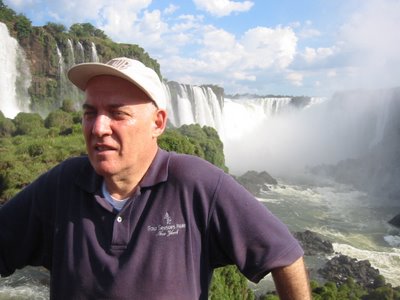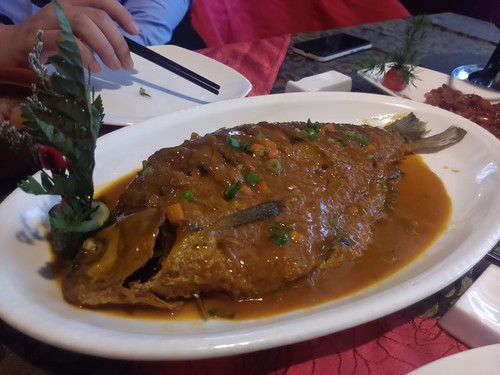
Howie at Iguazo after the "safe incident" in Buenos Aires
The most regular Google hits this site gets come from people finding a piece I wrote last Christmas called
Is Morocco A Safe Place To Visit?. My conclusion, having visited the country a dozen times since 1969, is that it is. Now you don't have to go traveling around the world to find trouble; trouble'll find you anywhere, and certainly in Paris, London, New York, L.A., San Francisco, Sydney... yeah, anywhere. My luckless friend Roland has been to Marrakech three times and was robbed the first two times he was there. But I rate Marrakech safe, as well as the other big cities listed above, and Buenos Aires unsafe. Let me tell you why I came to that conclusion.
A few weeks ago, just before leaving for Buenos Aires, I was laughing about how Bush's drunken daughter was robbed in San Telmo, a Buenos Aires hotspot (while surrounded by her Secret Service bodyguards). I was laughing because there's no amount of grief that could come to that infamous family that I wouldn't find amusing-- and because the daughter is just like the father: an irresponsible jackass who can't figure out how to behave among people. However, once I spent some time in Buenos Aires I started feeling badly that I had laughed.
Everyone gets robbed in Buenos Aires.
Everyone? Well, no, that was an exaggeration. I wrote something the other day about how Americans that are afraid of anything foreign can stay at the Park Hyatt and be in a virtual plastic bubble of American-ness (including a safe and prophylactic environment).
On the other hand, I haven't met a single Argentine without a story about crime in Buenos Aires. Everyone who hasn't been robbed has a brother or sister or best friend who has. My friend in bucolic Posadas has two sisters who moved from Misiones to cosmopolitan Buenos Aires. Both have been robbed numerous times; one was robbed 6 times! Buenos Aires crime isn't all directed at tourists. It's directed at everyone, including tourists.
Conventional wisdom for travelers is always to be alert and use common sense and then you won't be a victim. Mostly that works. But it works less well in Buenos Aires. The stories are legion! You get everything from the mundane stuff: pickpockets, purse and camera snatchers, crooked taxi drivers... to some really exotic shit: roofies in the drink at night/naked and penniless in a strange place in the morning. I ran into a guy from Milwaukee who had driven his motorcycle all the way down from Wisconsin to Argentina. You have to be pretty tough to do that. And then he got to Buenos Aires. Tom has
a great web site about his trip, and the whole thing is worth reading just because he's such an engaing writer with a refreshing perspective. But here's a segment about his misadventures in Buenos Aires:
Sadly, the two most entertaining things to write about are also the most unfortunate for me. First, I was robbed. And, second, I flirted with the possibility of serious personal injury.
The robbery took place in the morning at a small park in one of the three medians that separate the lanes in the 14-lane avenue I referenced earlier. I was reading the paper, enjoying some breakfast, when I suddenly realized that a bird had just pooped in my yogurt and on my leg. I figured this to be revenge for not sharing my donut with the crowd of birds gathered around my feet. At right around this time, a man in his 50's walked by and motioned to the birds in the tree directly above me. I stood up to survey the breadth of the poop, at which point the man directed me to a cement post a short distance away where he claimed there was water. Near the post a woman in her thirties noticed my leg and offered some of her Kleenex while addressing me in an apologetic tone. I was not in the mood to have people wiping poop off my leg, so I brushed them away. It was on the way back to the hotel that I realized that my camera was not in my pocket.
I also had had a video camera and some cash on me, so they didn´t fleece me completely But I was pretty irritated, and I had evil thoughts of breaking all of that woman´s fingers one by one. Strangely, the more I thought about it, the less upset I got. It's one thing to be robbed, but to be bamboozled by a three-person (including the deuce squirter in the grassy knoll) squad in an elaborate artificial poop ploy is quite another. I admired their audacity and originality, and, as an aside, I believe that the fake poop recipe involved a spicy mustard.
Actually, it isn't all
that original. They were doing the exact same thing in Delhi in the 70's, around Connaught Place. It's just one of countless schemes Porteños have come up with to separate people from their money and possessions. Why Buenos Aires?
There are a lot of theories, although I should point out that most of the huge Latin American cities are crime infested and relatively unsafe. Argentina is a very materialistic place and somewhat superficial to boot. Everybody who's anybody-- or wants to be-- wants to at least
appear to be on top of things. That costs money. And of the 11 million residents of the city, a great many millions of them are poor. It
looks like a very prosperous city, a very, very prosperous city. But you don't have to go far from the core, away from the Microcentro, from Palermo, from Recoleta, Belgrano, Retiro, Barrio Norte before you run into some serious poverty. Shanties surround the city. And there are sections right in the heart of it you don't want to walk through. A ten minute stroll from the 4 Seasons and Park Hyatt you could stumble onto Villa 31, a ghetto that many Porteños claim is at the root of a good deal of the street crime in town. Along with urban myths about how teenage murderers cannot be legally punished and that kind of thing, you get a picture of Villa 31 being filled with young people sitting around and listening to cumbia all day-- think rap and hip-hop-- and very addicted to
Paco (think crack). You'll be hard-pressed to find too much sympathy among Argentines for the residents of Villa 31 and the other
villas miserias and their unfortunate inhabitants but here's
the other side of the story.
So what about me? You know how I walk everywhere-- and at all times of the day and night. I walk for miles and miles in any direction and sneer at anyone who tells me it's unsafe. Did I run into any of the famous Buenos Aires street crime? Not first hand. But that doesn't mean I wasn't robbed. I wasn't robbed in one of the
villas miserias though; I was robbed in Recoleta, Buenos Aires' "Beverly Hills." I was the victim of a trick at least as old as the one that Tom fell for with the pigeon poop.
I rented an apartment through a "reputable" Argentine agency that connects landlords with tourists who are spending at least a week in the capital,
ByTArgentina. I picked an apartment in an upscale building on Posadas, a pretty posh street. I figured I would play it safe for my first week. What a joke! The landlady, Graciela Ujaque de Narnesi (Grace Ujaque of Buenos Aires and Miami) met me at the apartment and gave me a key to the safe so I could leave my money in it. When I left a week later, $500 was missing from the safe. ByTArgentina promised they'd get back to me; they haven't. Does that mean I won't go back to Buenos Aires? of course not. I'll just be... more alert next time.
WHAT ABOUT MEXICO CITY? IS THAT ONE SAFE?Like I said, there are problems with all the big Latin American cities, not just Buenos Aires. New Years Eve's
Washington Post did a story on the safety of traveling to Mexico's gigantic capital. The article talks about
politically motivated problems and common street crime. "Street crime also has long plagued this 580-square-mile, traffic-clogged metropolis of more than 20 million residents. The list of crimes encountered by travelers is daunting: pickpocketing, purse snatching, mugging, armed robbery and rape, according to the U.S. State Department's consular information sheet on Mexico. 'Instant kidnappings,' in which the victims are abducted at gunpoint and forced to empty their bank accounts to pay a ransom, also are common. Even hailing taxis is considered risky. Is a trip to a place with so many sore spots worth it? And if you go, how best to stay safe?"
The writer insists that Mexico City has a lot of draws recommending it. He recommends avoiding certain neighborhoods and suggests avoiding oft-used scams and ye olde bullshyte line about taking "every precaution you would in any large city." As well as carrying minimal cash, leaving the bling back home and trying to "blend in." (The jewelry business in Argentina is ruined because no Portenos in their right minds wear anything real anymore.) He thinks you'll be safer if you avoid areas around the airport and central train station-- a good idea in any big city anywhere-- as well as Garibaldi Square, Pensil, Tepito, Buenos Aires and Santa Julia, the area behind the National Palace and the Zocolo at night.
Everyone says the green and white VW bug taxis are to be avoided. Even a U.S. Embassy employee in Asuncion warned me against them! The hotel concierges say the same thing about the non-radio hotels in Buenos Aires, although I found them problem-free (and less expensive).
UPDATE: GUANGZHOU IS WAY WORSEHong Kong is as close as I ever got to Guangzhou (Canton when I was a geography student), although I always wanted to go. After reading about the
Hand Choppers, a motorcycle gang that doesn't bother removing a purse or ring but opts for severing the whole hand, I've decided to stick to Shanghai and Beijing.


















